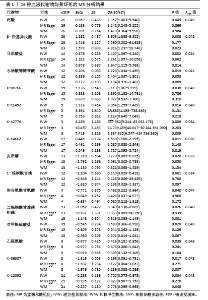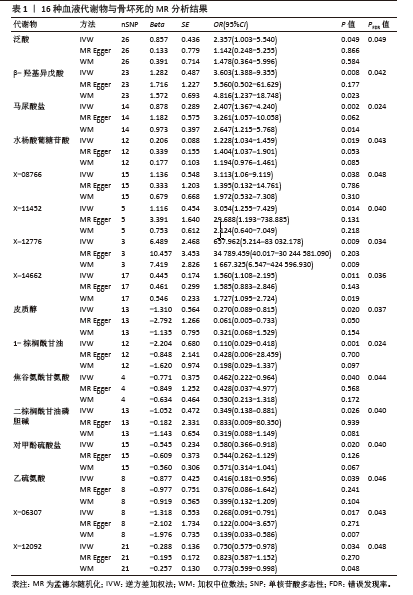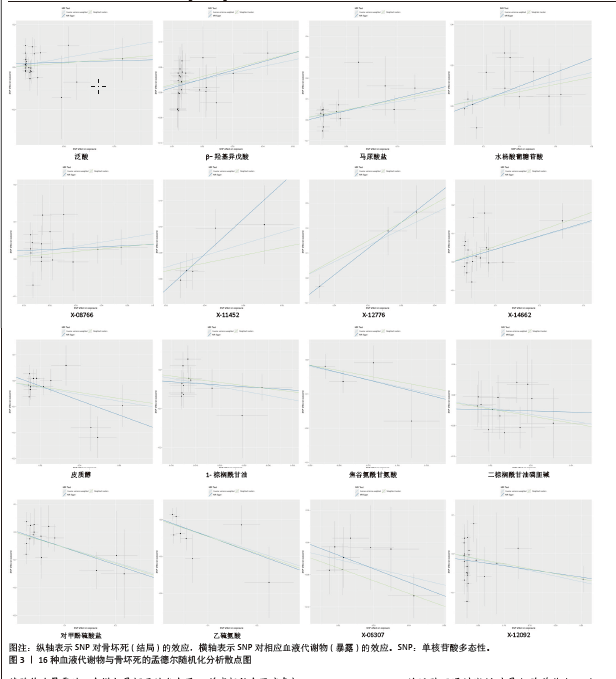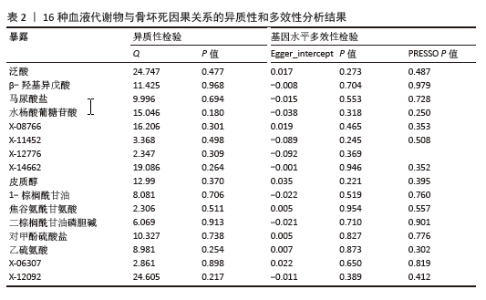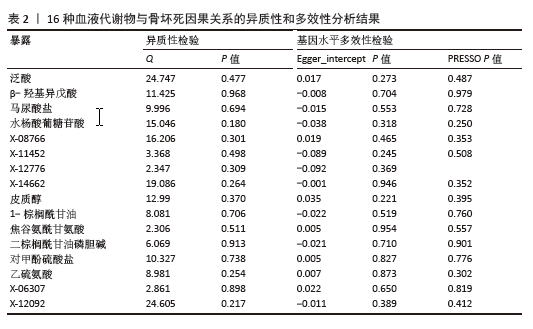Chinese Journal of Tissue Engineering Research ›› 2026, Vol. 30 ›› Issue (3): 785-794.doi: 10.12307/2026.007
Previous Articles Next Articles
A genetic perspective reveals the relationship between blood metabolites and osteonecrosis: an analysis of information from the FinnGen database in Finland
Liu Chu1, 2, Qiu Boyuan1, Tong Siwen1, He Linyuwei1, Chen Haobo1, Ou Zhixue2
- 1Graduate School of Guangxi University of Chinese Medicine, Nanning 530000, Guangxi Zhuang Autonomous Region, China; 2Department of Joint and Sports Medicine, Guilin Traditional Chinese Medicine Hospital, Guilin 541000, Guangxi Zhuang Autonomous Region, China
-
Received:2024-11-20Accepted:2025-01-06Online:2026-01-28Published:2025-07-10 -
Contact:Ou Zhixue, Chief physician, MD, Professor, Department of Joint and Sports Medicine, Guilin Traditional Chinese Medicine Hospital, Guilin 541000, Guangxi Zhuang Autonomous Region, China -
About author:Liu Chu, Master candidate, Graduate School of Guangxi University of Chinese Medicine, Nanning 530000, Guangxi Zhuang Autonomous Region, China; Department of Joint and Sports Medicine, Guilin Traditional Chinese Medicine Hospital, Guilin 541000, Guangxi Zhuang Autonomous Region, China -
Supported by:Guangxi Natural Science Foundation Project, No. 2023GXNSFAA026412 (to OZX); Scientific Research Project of the Administration of Traditional Chinese Medicine of Guangxi Zhuang Autonomous Region, No. GXZYZ20210372 (to OZX); Scientific Research Project of Guilin Science and Technology Bureau, No. 20210227-11-1 (to OZX)
CLC Number:
Cite this article
Liu Chu, Qiu Boyuan, Tong Siwen, He Linyuwei, Chen Haobo, Ou Zhixue. A genetic perspective reveals the relationship between blood metabolites and osteonecrosis: an analysis of information from the FinnGen database in Finland[J]. Chinese Journal of Tissue Engineering Research, 2026, 30(3): 785-794.
share this article
Add to citation manager EndNote|Reference Manager|ProCite|BibTeX|RefWorks
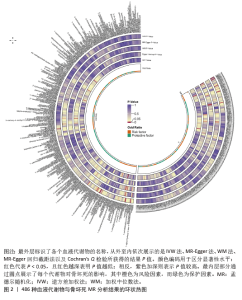
2.1 工具变量的选取结果 根据所设置的工具变量选择标准(P < 1×10-5,r2 < 0.001,kb=10 000,F > 10),对486种血液代谢物进行了筛选。最终获得的工具变量中,SNPs数量为3-156个,每个SNP的F值均超过10,排除了弱工具变量的影响。未发现工具变量与混杂因素相关的情况,所有工具变量均符合孟德尔随机化分析的三大核心假设,从而支持后续分析。 2.2 血液代谢物与骨坏死之间的因果效应 最初通过IVW筛选出20种血液代谢物与骨坏死之间存在潜在因果关系(PIVW < 0.05)。486种血液代谢物与骨坏死的孟德尔随机化分析结果详见图2。为进一步减少假阳性,使用错误发现率校正后,发现2种代谢物(苏氨酸酯、X-13549)的PFDR > 0.05;此外,MR-Egger法和加权中位数法分析显示,2种代谢物[5-十二碳烯酸 (12:1n7)、X-14977]的OR值方向不一致。上述4种血液代谢物均未达到筛选标准,最终确定了16种血液代谢物(包括10种已知代谢物和6种未知代谢物)与骨坏死之间存在显著的因果关系(PIVW < PFDR < 0.05),其中有8种血液代谢物有增加患骨坏死的风险(4种已知代谢物和4种未知代谢物),包括泛酸(pantothenate,OR=2.357,95%CI:1.003-5.540,PIVW=0.049,PFDR=0.049)、β-羟基异戊酸(beta-hydroxyisovalerate,OR=3.603,95%CI:1.388-9.355,PIVW=0.008,PFDR=0.042)、马尿酸盐(hippurate,OR=2.407,95%CI:1.367-4.240,PIVW=0.002,PFDR=0.024)、水杨酸葡糖苷酸(salicyluric glucuronide,OR=1.228,95%CI:1.034-1.459,PIVW=0.019,PFDR=0.043)、X-08766(OR=3.113,95%CI:1.063-9.119,PIVW=0.038,PFDR=0.048)、X-11452(OR=3.054,95%CI:1.255-7.429,PIVW=0.014,PFDR=0.04)、X-12776(OR=657.962,95%CI:5.214-83 032.178,PIVW=0.009,PFDR=0.034)、X-14662(OR=1.560,95%CI:1.108-2.195,PIVW=0.011,PFDR=0.036);另外有8种血液代谢物降低骨坏死的风险(6种已知代谢物和2种未知代谢物),包括皮质醇(cortisol,OR=0.270,95%CI:0.089-0.815,PIVW=0.02,PFDR=0.037)、1-棕榈酰甘油[1-palmitoylglycerol (1-monopalmitin),OR=0.11,95%CI:0.029-0.418,PIVW=0.001,PFDR=0.024]、焦谷氨酰甘氨酸(pyroglutamylglycine,OR=0.462,95%CI:0.222-0.964,PIVW=0.04,PFDR=0.044)、二棕榈酰甘油磷胆碱(2-stearoylglycerophosphocholine,OR=0.349,95%CI:0.138-0.881,PIVW=0.026,PFDR=0.04)、对甲酚硫酸盐(p-cresol sulfate,OR=0.580,95%CI:0.366-0.918,PIVW=0.02,PFDR=0.04)、乙硫氨酸(ergothioneine,OR=0.416,95%CI:0.181-0.956,PIVW=0.039,PFDR=0.046)、X-06307(OR=0.268,95%CI:0.091-0.719,PIVW=0.017,PFDR=0.043)、X-12092(OR=0.75,95%CI:0.575-0.978,PIVW=0.034,PFDR=0.048),见表1及图3。"
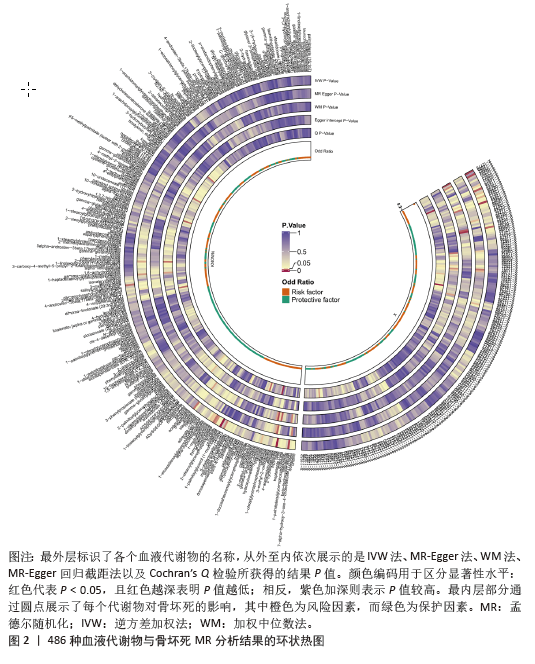

2.3.2 基因水平多效性检验 在使用MR-PRESSO方法进行分析的过程中,除代谢物X-12776由于其SNPs数目有限而无法评估外,其他所有代谢物均未显示出显著的基因水平多效性(P > 0.05),同时也没有观察到离群值的存在。为了确保结论的稳健性,还进行了MR-Egger回归截距分析,结果提示截距均接近于零,进一步确认了16种血液代谢物不存在基因水平多效性(P > 0.05)。这些结果共同证明了选定SNPs符合孟德尔随机化分析中所需的独立性和排他性假设。详细的分析结果见表2。 2.3.3 留一法分析 在进行留一法检验时,逐一排除了每个SNPs后,使用剩余的SNPs重新计算了代谢物与骨坏死之间的关联效应,并未观察到明显的离群值或整体效应估计的重大改变。这一结果表明,没有单一的SNPs对总体分析结果造成显著影响,从而进一步证实了此次研究结论的可靠性和稳健性。详细结果请参见图4。 2.4 Steiger方向性测试 通过前期的分析,确认了16种血液代谢物与骨坏死之间存在正向因果关系。进一步的Steiger方向性测试结果显示,未发现骨坏死对这16种血液代谢物有反向因果影响,每个SNP的Steiger_dir结果均为TURE,这进一步验证了正向因果关系的可靠性。"

| [1] CHANG C, GREENSPAN A, GERSHWIN ME. The pathogenesis, diagnosis and clinical manifestations of steroid-induced osteonecrosis. J Autoimmu. 2020;110:102460. [2] WANG X, HU L, WEI B, et al. Regenerative therapies for femoral head necrosis in the past two decades: a systematic review and network meta-analysis. Stem Cell Res Ther. 2024;15(1):21. [3] LOU P, ZHOU G, WEI B, et al. Bone grafting for femoral head necrosis in the past decade: a systematic review and network meta-analysis. Int J Surg. 2023;109(3):412-418. [4] ABU-SHAKRA M, BUSKILA D, SHOENFELD Y. Osteonecrosis in patients with SLE. Clin Rev Allergy Immunol. 2003;25:13-23. [5] MURPHEY MD, FOREMAN KL, KLASSEN-FISCHER MK, et al. From the radiologic pathology archives imaging of osteonecrosis: radiologic-pathologic correlation. Radiographics. 2014;34(4):1003-1028. [6] LI W, LI W, ZHANG W, et al. Exogenous melatonin ameliorates steroid-induced osteonecrosis of the femoral head by modulating ferroptosis through GDF15-mediated signaling. Stem Cell Res Ther. 2023; 14(1):171. [7] QIU S, CAI Y, YAO H, et al. Small molecule metabolites: discovery of biomarkers and therapeutic targets. Signal Transduct Target Ther. 2023;8(1):132. [8] LIU X, LI Q, SHENG J, et al. Unique plasma metabolomic signature of osteonecrosis of the femoral head. J Orthop Res. 2016;34(7): 1158-1167. [9] GUO MK, ZHANG J. Metabolomic analysis of bone-derived exosomes in osteonecrosis of the femoral head based on UPLC–MS/MS. Metabolomics. 2023;19(4):34. [10] PEREIRA TCS, SOUZA AR, DALTRO PB, et al. Blood plasma and bone marrow interstitial fluid metabolomics of sickle cell disease patients with osteonecrosis: An exploratory study to dissect biochemical alterations. Clin Chim Acta. 2023;539:18-25. [11] AU YEUNG SL, GILL D. Standardizing the reporting of Mendelian randomization studies. BMC Med. 2023;21(1):187. [12] FERENCE BA, HOLMES MV, SMITH GD. Using Mendelian randomization to improve the design of randomized trials. Cold Spring Harb Perspect Med. 2021;11(7):a040980. [13] DAVIES NM, HOLMES MV, SMITH GD. Reading Mendelian randomisation studies: a guide, glossary, and checklist for clinicians. BMJ. 2018;362:k601. [14] SHIN SY, FAUMAN EB, PETERSEN AK, et al. An atlas of genetic influences on human blood metabolites. Nat Genet. 2014;46(6):543-550. [15] ZENG X, ZHONG B. Investigating the causal relationship between human blood metabolites and pulmonary hypertension: a two-sample Mendelian randomization study. Front Cardiovasc Med. 2024;11:1304986. [16] LI P, WANG H, GUO L, et al. Association between gut microbiota and preeclampsia-eclampsia: a two-sample Mendelian randomization study. BMC Med. 2022;20(1):443. [17] CAO Y, LU H, XU W, et al. Gut microbiota and Sjögren’s syndrome: A two-sample Mendelian randomization study. Front Immunol. 2023;14: 1187906. [18] XU J, ZHANG S, TIAN Y, et al. Genetic causal association between iron status and osteoarthritis: a two-sample mendelian randomization. Nutrients. 2022;14(18):3683. [19] WANG C, ZHU Y, PAN D. Identifying the causal relationship between immune factors and osteonecrosis: a two-sample Mendelian randomization study. Sci Rep. 2024;14(1): 9371. [20] LI W, XU JW, CHAI JL, et al. Complex causal association between genetically predicted 731 immunocyte phenotype and osteonecrosis: a bidirectional two-sample Mendelian randomization analysis. Int J Surg. 2024;110(6):3285-3293. [21] CHEN S, LIU J, ZHANG N, et al. Exploring of exosomes in pathogenesis, diagnosis and therapeutic of osteonecrosis of the femoral head: the mechanisms and signaling pathways. Biomed Mater. 2024;19(5):052006. [22] EHMKE TA, CHERIAN JJ, WU ES, et al. Treatment of osteonecrosis in systemic lupus erythematosus: a review. Curr Rheumatol Rep. 2014;16:1-9. [23] ÁLVAREZ-CÓRDOBA M, FERNÁNDEZ KHOURY A, VILLANUEVA-PAZ M, et al. Pantothenate rescues iron accumulation in pantothenate kinase-associated neurodegeneration depending on the type of mutation. Mol Neurobiol. 2019;56:3638-3656. [24] MA Q, LIANG M, TANG X, et al. Vitamin B5 inhibit RANKL induced osteoclastogenesis and ovariectomy induced osteoporosis by scavenging ROS generation. Am J Transl Res. 2019;11(8):5008. [25] ZHAO G, ZHONG H, RAO T, et al. Metabolomic analysis reveals that the mechanism of astaxanthin improves the osteogenic differentiation potential in bone marrow mesenchymal stem cells. Oxid Med Cell Longev. 2020;2020(1):3427430. [26] SABOURIN PJ, BIEBER LL. Formation of β-hydroxyisovalerate by an α-ketoisocaproate oxygenase in human liver. Metabolism.1983;32(2):160-164. [27] MOCK DM, STRATTON SL, HORVATH TD, et al. Urinary excretion of 3-hydroxyisovaleric acid and 3-hydroxyisovaleryl carnitine increases in response to a leucine challenge in marginally biotin-deficient humans. J Nutr. 2011;141(11): 1925-1930. [28] MANJARÍN R, BOUTRY-REGARD C, SURYAWAN A, et al. Intermittent leucine pulses during continuous feeding alters novel components involved in skeletal muscle growth of neonatal pigs. Amino Acids. 2020; 52(9):1319-1335. [29] LI W, DONG H, NIU K, et al. Analyzing urinary hippuric acid as a metabolic health biomarker through a supramolecular architecture. Talanta. 2024;278:126480. [30] NAM M, HUH JE, KIM MS, et al. Metabolic alterations in the bone tissues of aged osteoporotic mice. Sci Rep. 2018;8(1):8127. [31] XU M, MOTOMURA G, UTSUNOMIYA T, et al. Effects of bone mineral density at the lateral sclerotic boundary on the femoral head collapse onset in osteonecrosis of the femoral head: A preliminary study. Clin Biomech (Bristol). 2024;111:106156. [32] LEI ZHU, ZHAO ZJ, REN XB, et al. Serum metabonomics of articular cartilage destruction induced by T-2 toxin in Wistar rats. Biomed Environ Sci. 2018;31(1):76-80. [33] LI JP, GUO JM, SHANG EX, et al. Quantitative determination of five metabolites of aspirin by UHPLC–MS/MS coupled with enzymatic reaction and its application to evaluate the effects of aspirin dosage on the metabolic profile. J Pharm Biomed Anal. 2017;138: 109-117. [34] DU M, PAN W, DUAN X, et al. Lower dosage of aspirin promotes cell growth and osteogenic differentiation in murine bone marrow stromal cells. J Dent Sci. 2016;11(3):315-322. [35] PARK JS, HONG HS. FGF2/HGF priming facilitates adipose-derived stem cell-mediated bone formation in osteoporotic defects. Heliyon. 2024;10(2):e24554. [36] DUAN P, YU YL, CHENG YN, et al. Exosomal miR-1a-3p derived from glucocorticoid-stimulated M1 macrophages promotes the adipogenic differentiation of BMSCs in glucocorticoid-associated osteonecrosis of the femoral head by targeting Cebpz. J Nanobiotechnology. 2024;22(1):648. [37] TE WINKEL ML, PIETERS R, WIND EJD, et al. Management and treatment of osteonecrosis in children and adolescents with acute lymphoblastic leukemia. Haematologica. 2014;99(3):430. [38] LIU J, HUANG X, LV T, et al. Intra-articular injection of chitosan combined with low-dose glucocorticoid for the treatment of knee osteoarthritis in early and middle stages. Medicine (Baltimore). 2024;103(40):e39924. [39] NIU L, LI W, CHEN X, et al. 1‐Monopalmitin promotes lung cancer cells apoptosis through PI3K/Akt pathway in vitro. Environ Toxicol. 2023;38(11):2621-2631. [40] LIN C, JIANG H, LOU C, et al. Asiatic acid prevents glucocorticoid-induced femoral head osteonecrosis via PI3K/AKT pathway. Int Immunopharmacol. 2024;130:111758. [41] HUANG LK, ZENG XS, JIANG ZW, et al. Echinacoside alleviates glucocorticoid induce osteonecrosis of femoral head in rats through PI3K/AKT/FOXO1 pathway. Chem Biol Interact. 2024;391:110893. [42] YAN Y, YU Y, LIU J, et al. Lipid metabolism analysis for peripheral blood in patients with alcohol-induced and steroid-induced osteonecrosis of the femoral head. Zhong Nan Da Xue Xue Bao Yi Xue Ban. 2022;47(7):872-880. [43] GAY CV, GILMAN VR, SUGIYAMA T. Perspectives on osteoblast and osteoclast function. Poult Sci. 2000;79(7):1005-1008. [44] LONG X, ZHANG Y, LIU M, et al. Causality of genetically determined blood metabolites on inflammatory bowel disease: a two-sample Mendelian randomization study. Sci Rep. 2024; 14(1):16361. [45] YAN H, ZHAO S, HUANG HX, et al. Systematic Mendelian randomization study of the effect of gut microbiome and plasma metabolome on severe COVID-19. Front Immunol. 2023;14: 1211612. [46] TABE S, HIKIJI H, HASHIDATE‐YOSHIDA T, et al. The role of lysophosphatidylcholine acyltransferase 2 in osteoblastic differentiation of C2C12 cells. FEBS Open Bio. 2024;14(9): 1490-1502. [47] ZHANG B, HE W, PEI Z, et al. Plasma proteins, circulating metabolites mediate causal inference studies on the effect of gut bacteria on the risk of osteoporosis development. Ageing Res Rev. 2024;101:102479. [48] GRYP T, VANHOLDER R, VANEECHOUTTE M, et al. p-Cresyl sulfate. Toxins (Basel). 2017;9(2):52. [49] LUBKOWICZ D, HAVA DL, LEWIS K, et al. Rational Engineering of Escherichia coli Nissle 1917 as Live Biotherapeutic to Degrade Uremic Toxin Precursors. ACS Synth Biol. 2024;13(4):1077-1084. [50] WYPYCH TP, PATTARONI C, PERDIJK O, et al. Microbial metabolism of L-tyrosine protects against allergic airway inflammation. Nat Immunol. 2021;22(3):279-286. [51] BRIAL F, ALZAID F, SONOMURA K, et al. The natural metabolite 4-cresol improves glucose homeostasis and enhances β-cell function. Cell Rep. 2020;30(7):2306-2320. e5. [52] YAN Y, WANG J, HUANG D, et al. Plasma lipidomics analysis reveals altered lipids signature in patients with osteonecrosis of the femoral head. Metabolomics. 2022;18(2):14. [53] BAEK SH, KIM KH, LEE WK, et al. Abnormal lipid profiles in nontraumatic osteonecrosis of the femoral Head: a comparison with osteoarthritis using propensity score matching. J Bone Joint Surg Am. 2022;104(Suppl 2):19-24. [54] JIA D, ZHANG Y, LI H, et al. Predicting steroid-induced osteonecrosis of the femoral head: role of lipid metabolism biomarkers and radiomics in young and middle-aged adults. J Orthop Surg Res. 2024;19(1):749. [55] THOMAS TA, FRANCIS RO, ZIMRING JC, et al. The Role of Ergothioneine in Red Blood Cell Biology: A Review and Perspective. Antioxidants (Basel). 2024;13(6):717. [56] FU TT, SHEN L. Ergothioneine as a natural antioxidant against oxidative stress-related diseases. Front Pharmacol. 2022;13:850813. [57] SAKATA S, KUNIMATSU R, TANIMOTO K. Protective Effect of Ergothioneine against Oxidative Stress-Induced Chondrocyte Death. Antioxidants (Basel). 2024;13(7):800. [58] YANG Y, JIAN Y, LIU Y, et al. Mitochondrial maintenance as a novel target for treating steroid-induced osteonecrosis of femoral head: a narrative review. EFORT Open Rev .2024;9(11):1013-1022. [59] CHEN K, LIU Y, HE J, et al. Steroid-induced osteonecrosis of the femoral head reveals enhanced reactive oxygen species and hyperactive osteoclasts. Int J Biol Sci. 2020;16(11):1888. [60] ZHANG X, FENG C, YUAN T, et al. Inhibition of protein disulfide isomerase mitigates steroid-induced osteonecrosis of the femoral head by suppressing osteoclast activity through the reduction of cellular oxidative stress. Chem Biol Interact. 2024;404:111263. |
| [1] | Yang Zhijie, Zhao Rui, Yang Haolin, Li Xiaoyun, Li Yangbo, Huang Jiachun, Lin Yanping, Wan Lei, HuangHongxing. Postmenopausal osteoporosis: predictive values of muscle mass, grip strength, and appendicular skeletal muscle index [J]. Chinese Journal of Tissue Engineering Research, 2026, 30(5): 1073-1080. |
| [2] | Yin Yongcheng, Zhao Xiangrui, Yang Zhijie, Li Zheng, Li Fang, Ning Bin. Effect and mechanism of peroxiredoxin 1 in microglial inflammation after spinal cord injury [J]. Chinese Journal of Tissue Engineering Research, 2026, 30(5): 1106-1113. |
| [3] | Zhang Jiuxuan, Zhang Jinnan, Sui Xiaofan, Pei Xiaxia, Wei Jianhong, Su Qiang, Li Tian. Effects of ammonia poisoning on cognitive behavior and hippocampal synaptic damage in mice [J]. Chinese Journal of Tissue Engineering Research, 2026, 30(5): 1122-1128. |
| [4] | Sun Yajie, Zhao Xinchen, Bo Shuangling. Spatiotemporal expression of bone morphologic protein 7 in mouse kidney development [J]. Chinese Journal of Tissue Engineering Research, 2026, 30(5): 1156-1161. |
| [5] | Li Haojing, Wang Xin, Song Chenglin, Zhang Shengnan, Chen Yunxin. Therapeutic efficacy of extracorporeal shock wave therapy in the upper trapezius muscle area combined with exercise control training in patients with chronic non-specific neck pain [J]. Chinese Journal of Tissue Engineering Research, 2026, 30(5): 1162-1170. |
| [6] | Liu Yu, Lei Senlin, Zhou Jintao, Liu Hui, Li Xianhui. Mechanisms by which aerobic and resistance exercises improve obesity-related cognitive impairment [J]. Chinese Journal of Tissue Engineering Research, 2026, 30(5): 1171-1183. |
| [7] | Yu Huifen, Mo Licun, Cheng Leping. The position and role of 5-hydroxytryptamine in the repair of tissue injury [J]. Chinese Journal of Tissue Engineering Research, 2026, 30(5): 1196-1206. |
| [8] | Wang Zhengye, Liu Wanlin, Zhao Zhenqun. Advance in the mechanisms underlying miRNAs in steroid-induced osteonecrosis of the femoral head [J]. Chinese Journal of Tissue Engineering Research, 2026, 30(5): 1207-1214. |
| [9] | Bu Yangyang, Ning Xinli, Zhao Chen. Intra-articular injections for the treatment of osteoarthritis of the temporomandibular joint: different drugs with multiple combined treatment options [J]. Chinese Journal of Tissue Engineering Research, 2026, 30(5): 1215-1224. |
| [10] | Wen Fan, Xiang Yang, Zhu Huan, Tuo Yanfang, Li Feng. Exercise improves microvascular function in patients with type 2 diabetes [J]. Chinese Journal of Tissue Engineering Research, 2026, 30(5): 1225-1235. |
| [11] | Liu Xinyue, Li Chunnian, Li Yizhuo, Xu Shifang. Regeneration and repair of oral alveolar bone defects [J]. Chinese Journal of Tissue Engineering Research, 2026, 30(5): 1247-1259. |
| [12] | Leng Xiaoxuan, Zhao Yuxin, Liu Xihua. Effects of different neuromodulatory stimulation modalities on non-motor symptoms in Parkinson’s patients: a network meta-analysis [J]. Chinese Journal of Tissue Engineering Research, 2026, 30(5): 1282-1293. |
| [13] | Wen Xiaolong, Weng Xiquan, Feng Yao, Cao Wenyan, Liu Yuqian, Wang Haitao. Effects of inflammation on serum hepcidin and iron metabolism related parameters in patients with type 2 diabetes mellitus: a meta-analysis [J]. Chinese Journal of Tissue Engineering Research, 2026, 30(5): 1294-1301. |
| [14] | Gao Zengjie, , Pu Xiang, Li Lailai, Chai Yihui, Huang Hua, Qin Yu. Increased risk of osteoporotic pathological fractures associated with sterol esters: evidence from IEU-GWAS and FinnGen databases [J]. Chinese Journal of Tissue Engineering Research, 2026, 30(5): 1302-1310. |
| [15] | Liu Fengzhi, Dong Yuna, Tian Wenyi, Wang Chunlei, Liang Xiaodong, Bao Lin. Gene-predicted associations between 731 immune cell phenotypes and rheumatoid arthritis [J]. Chinese Journal of Tissue Engineering Research, 2026, 30(5): 1311-1319. |
| Viewed | ||||||
|
Full text |
|
|||||
|
Abstract |
|
|||||
